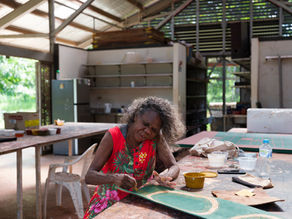Region Profile - Warumpi (Papunya)
- Jason Leven

- Apr 20, 2024
- 1 min read
The Papunya settlement 240 km northwest of Alice Springs (Mparntwe), was established during the 1960s as an administrative centre for forcibly resettled Pintupi, Luritja, Walpiri, Arrernte, and Anmatyerre peoples whose homelands covered almost one-third of the Australian continent.

The Western Desert is by many considered the birthplace of the modern Aboriginal art movement - usually referring to the style many define as ‘dot painting’. It was in Papunya that the first group of Pintupi elders began using acrylic paint to record aspects of their culture on canvas in the early 1970s.
During the following decade, the homelands movement saw many Pintupi and Luritja people move back to their homelands and continue their strong ceremonial tie to the Land. As they did so, numerous art centres were established throughout the Central and Western desert regions.

The Papunya painting style derives directly from the artists’ knowledge of traditional body and sand painting associated with ceremony. As the artists portrayed their Dreamtime creation stories for the public, they removed or concealed their most sacred symbols, carefully monitoring their ancestral designs in order to protect the sacred knowledge encoded in their art.
NYURAPAYIA NAMPITJINPA (MRS BENNETT) UNTITLED, 2001 91 x 61 cm Synthetic Polymer Paint on Belgian Linen $3,500 | PROVENANCE Papunya Tula Artists, NT Cat No. NN011183 Private Collection, NSW Cooee Art Leven, Sydney NSW |
NINGURA GIBSON NAPURRULA WIRRULNGA, 2009120 x 152 cm Synthetic Polymer Paint on Belgian Linen $12,000 | PROVENANCE Papunya Tula Artists, NT Cat No. NN0409069 Private Collection, NSW Cooee Art Leven, Sydney NSW |









